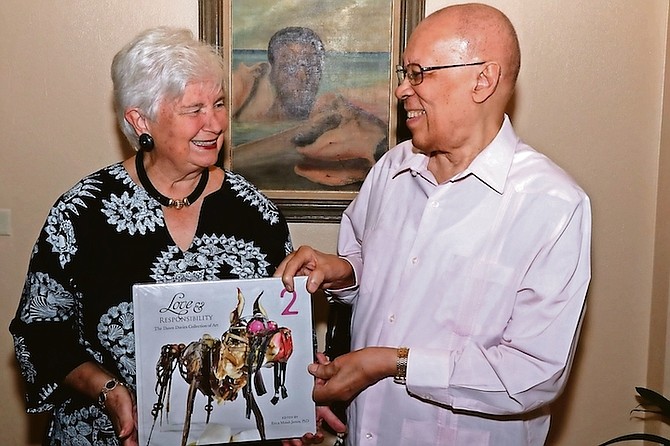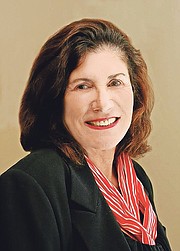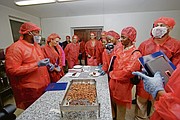THE first thing Dawn Davies says when you walk into her home which is less house and more living museum with art everywhere - on walls, tables, in hallways, even on the ceiling - “Among the important art works displayed, I like a bit of whimsy, including the folksy, kitsch and craft.” It’s a brief introduction to a collection of such variety and breadth that it would defy description if it were not for one common element. It is Bahamian through and through, art by Bahamians or about Bahamian life, including nostalgic Bahamas pieces by visitors from as long ago as the 1800s.
It’s a good thing Davies knows where to start the tour d’art because the average viewer, including this writer, wouldn’t have a clue. There is quite literally art everywhere you look, from the bus stop sign with waiting skeletons in the driveway parking area, to Tyrone Ferguson’s courting ‘froganooer’ sculptures in the garden, to a much more serious, even dark side.
I am there, revelling in this delightfully rich touring experience because Davies has just published her third book, the second in a series called Love & Responsibility –The Dawn Davies Collection of Art. Oversized and majestically produced, with photos by the late Roland Rose, Volume 2 offers a foreword by Sir Arthur Foulkes and essays by the elite in the Bahamian art world. It is edited by Erica James, PhD, and beautifully laid-out by graphic designer Dionne Benjamin-Smith. The second volume, like the first Love & Responsibility, catalogues Dawn Davies’ jaw-dropping, brilliant and diverse collection.
Handling both of the voluminous books with more than 500 pages and weighing some eight pounds each could substitute for a good work-out at the gym.
Even with the growing and welcome library of books by Bahamian authors or photo essays of The Bahamas by photographic artists like Alessandro Sarno, there is nothing comparable to the two volumes of Love & Responsibility. And that is because there are few comparable to the indomitable collector. Dawn Davies has spent her adult life supporting young artists, buying and showing their work, recognising talent when it was still in its embryonic stages, smiling at and collecting kitsch and craft, occasionally lending emotional support when financial was not enough.
Davies’ collection is, despite her protestation, still growing. Odd as it seems, this is not the largest collection in The Bahamas, but it will be among the most comprehensive of Bahamian art, including just about every name that ever put oil, acrylic or watercolour to paper or canvas, every sculptor who subjected metal to fire, every potter who turned a clay concept into an object to hold or admire, even those who took the playful and made it whimsical. From the thought-provoking work of Lavar Munroe to the incomparable Tavares Strachan, from the multi-tiered talent of John Cox to a frivolous drunken mouse with a spilled glass of wine by Anne Bruce, from the ceramic art of Jessica Colebrooke to the Bahamian woman studies by Chantal Bethel, from the triumphant work by Stanley Burnside to the originals by deceased masters like Brent Malone and Denis Knight, from works by impressionist Ricardo Knowles to the uplifting ones by Antonius Roberts, and apologies to the many artists whose name space does not permit me to mention, the collection is so varied it is hard to wrap one’s eyes around it, making the two volumes of the collection important for general pleasure as well as art history.
In fact, it is so large it seems at times to take the collector herself by surprise. As she says in Volume 2: “I ask myself, how on earth did this happen?”
We continue the tour and I have to remind myself that this is someone’s home where dinner is served at night, and a garden where coffee may be enjoyed in the morning beside a mural by Angelika Wallace-Whitfield, and where it can appear to rain over and around a gazebo for ambiance, when desired.
“In the garden, I like to turn a corner and see something fun and new,” she says, and that you do. Every corner holds another treasure. Art extends from inside the house throughout the outdoor space where art lives amidst greenery. In one section is a tribute to her late brother, nearby a life-size donkey and dray. Not far away sits Gussie Mae on a stool watching over her fruit stand, all lifelike tiles by Jessica Colebrooke. Indoors, hanging under a painting by Amos Ferguson, a sculpture of a horse and carriage with cigar-smoking driver and tourist riding in the back seat with camera around his neck, is a work of painstaking detail by plumber Nick Austin who is probably better known for his detailed copper works.
Davies points out a captivating, if almost moody, work by Thierry Lamare, instantly recognizable dramatic ceramic sculptures by Colebrooke and others by Imogene Walkine. She stops and stares as if she is seeing it again for the first time works by Brent Malone and Kendal Hanna, then moves slowly, deliberately to a large work by Heino Schmid of what appears to be an abandoned, sleeping or dead dog, and then on to a third disturbing, soul-searching work by Lavar Munroe. “Not everything in life is beautiful,” says the collector who admits in the early days to collecting only pretty paintings that depicted the beauty of the islands “and not everything in art should be beautiful.” The collection started in 1969 with a painting that was a still life of a bowl of daisies by Alton Lowe of Abaco, a painting she still treasures.
Today, the Dawn Davies collection captures the best and the worst of humankind. It catalogues what we have done to one another and our surroundings, and lays bare the soul of The Bahamas from some of our darkest fears to our brightest smiles. And, in between, the collection shows the fabric of our lives, captured in one art form or another as it introduces subtle or sublime touches of humour, balancing the drama that art may represent.
The garden part of my tour is almost over when we pass an area where cut tree branches and lawn debris is kept, I chuckle at a posted sign, “Trespassers will be composted.” Davies smiles. No opportunity for a little more art or a touch of humour is overlooked in this house and garden of visual pleasures and treasures.
HOW MUCH CHOCOLATE WILL WE CONSUME?
NEARLY nine out of every 10 – 86 percent to be exact – of Americans plan to purchase chocolate between now and Valentine’s Day. In The Bahamas, where many of us condense our Christmas shopping into a trip to Lowe’s Pharmacy just before they close on Christmas Eve, the rush to remember the heart-shaped box may be closer to the 14th than to this weekend, but late or not, we’re likely to make chocolate part of our Valentine’s giving schedule.
According to the National Confectioners Association, Americans spent less on gifts and more on chocolate since the pandemic, up by 4.7 percent, with analysts predicting a $1 billion in profits during the season of love.
If our chocolate consumption is anything like that of Americans, it will show a significant uptick as well and that’s why I am making a personal appeal – please buy local. We have great chocolatiers in The Bahamas, Bootleg Chocolates in Grand Bahama which distributes in Nassau as well, and the world-famous Graycliff, where you can experience a spirits and chocolate tour, meaning toast and taste the right sweet with the right wine, or sign up for a chocolate-making class. The best part, savouring the product built bean-to-bar by your own hands.
I’d put Graycliff and Bootleg chocolates up against the most famous in the world, an export we do not export enough of, and supporting locals is a sweet boost to the economy. So, please, show The Bahamas and our entrepreneurs a little love this Valentine’s.







Comments
Use the comment form below to begin a discussion about this content.
Sign in to comment
Or login with:
OpenID